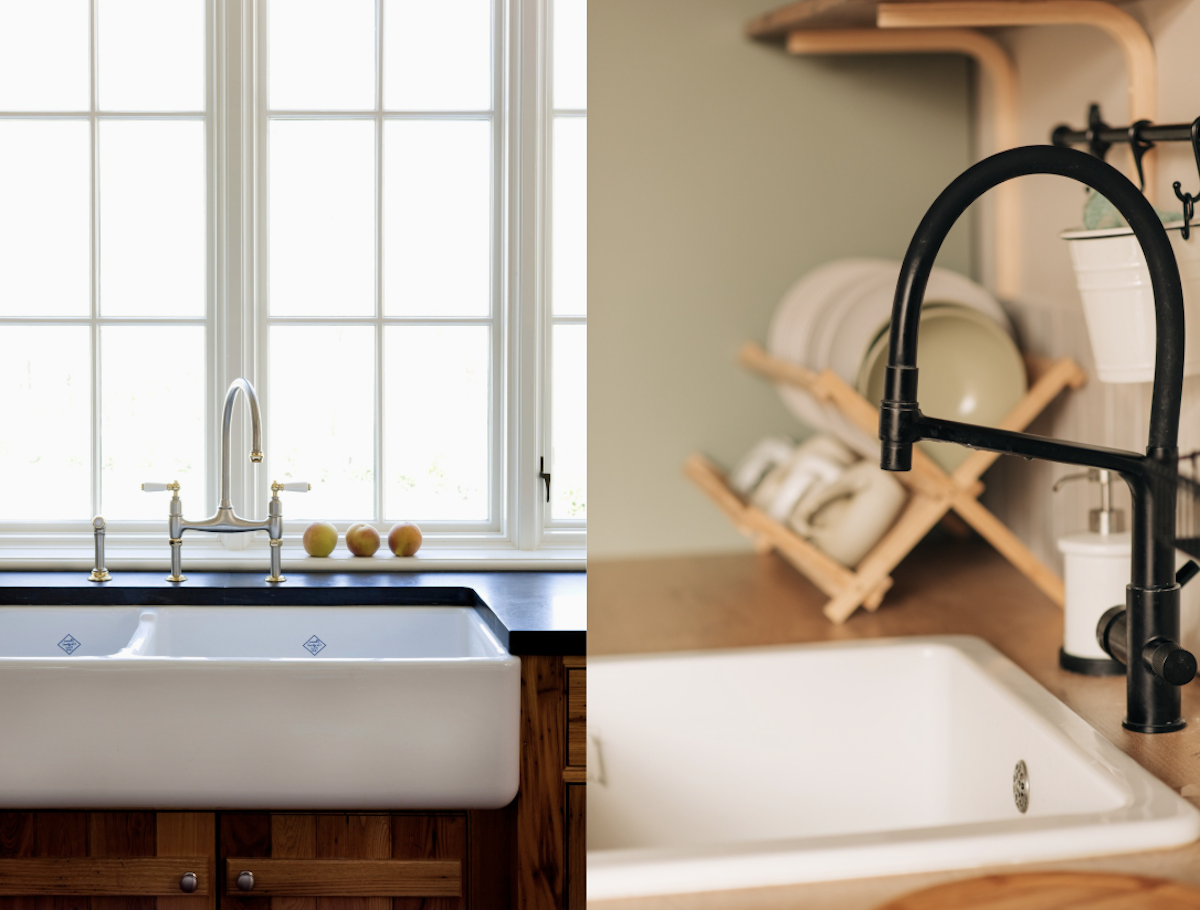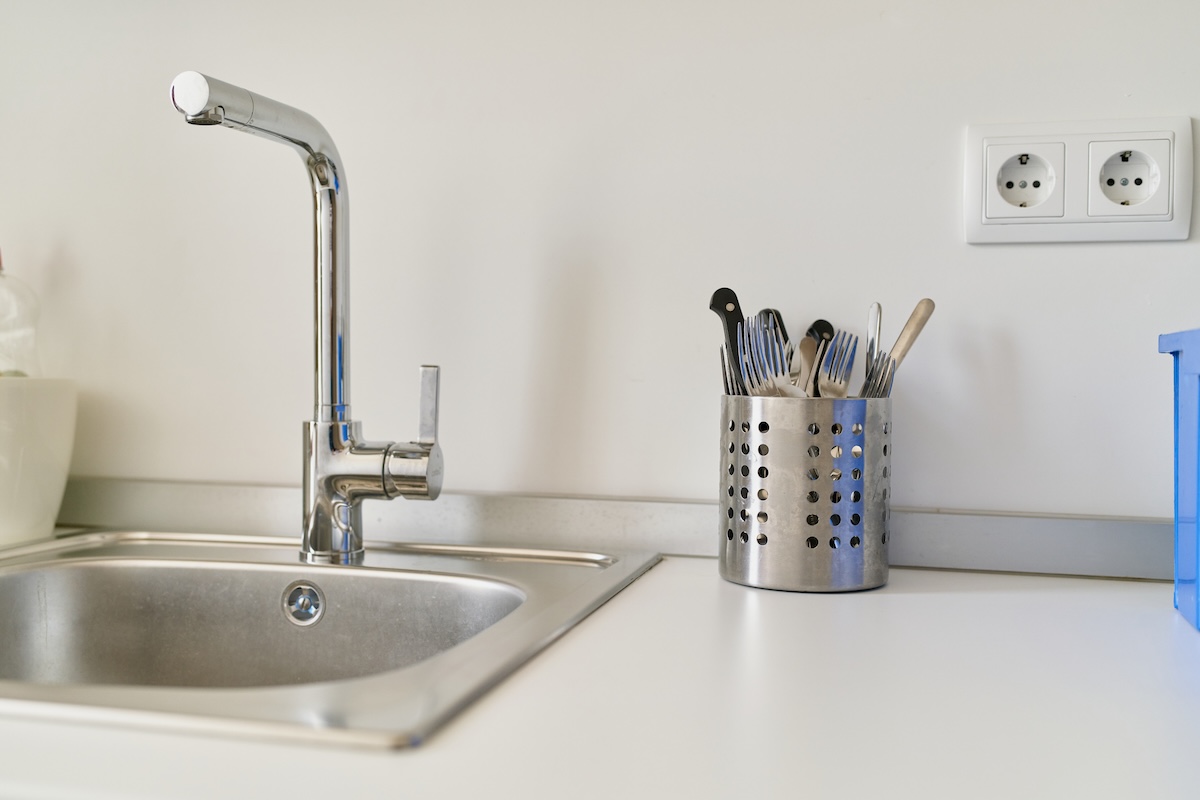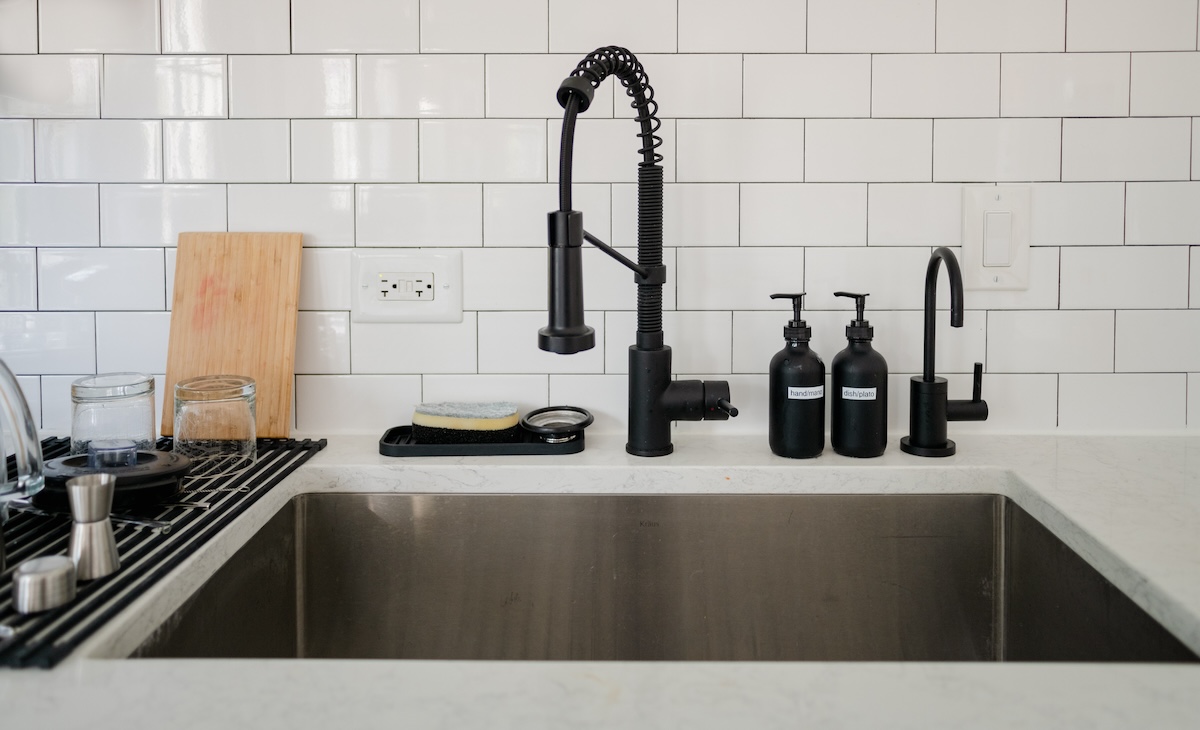

We may earn revenue from the products available on this page and participate in affiliate programs. Learn More ›
Designers and shoppers encounter a wide variety of sink styles for kitchens and bathrooms, but there are just two main ways to mount a sink: undermount and drop-in (also called top-mount or self-rimming).
What is the difference between undermount and drop-in sinks? It’s all about the installation method—and this also affects the ease of installation, installation costs, aesthetics, the cost of the sink itself, and everyday cleaning. To find out which type of sink is best for your kitchen, learn more about these two kitchen sink options as well as their pros and cons.
What is a drop-in sink?

Drop-in sinks, also called drop sinks, self-rimming sinks, or top-mount sinks, have long been popular options for both kitchen and bathroom sinks. As the name suggests, a drop-in sink drops into a hole cut in the countertop. A rim surrounding the sink supports most of the sink’s weight from the countertop and helps keep it in place. Installers place metal clips underneath the sink to secure the sink to the countertop, and add caulking around the perimeter to make a watertight seal between the sink rim and countertop.
Some sinks made of heavier materials, such as cast iron, don’t require clips because their weight helps them stay in place on their own, but note that a very heavy sink might require additional supports. Drop-in sinks come in a variety of materials, sizes, and styles, including single-bowl and double-bowl models.
What is an undermount sink?

Undermount sinks install directly under the countertop. Unlike drop-in sinks, undermounts have no lip or rim that sits on top of the countertop, so the overall look is sleek and modern. Like drop-in sinks, they come in a range of materials, sizes, styles, and configurations.
Undermount sinks have a rim that sits beneath the countertop, where it’s hidden from view. Installers secure the rim to the countertop using adhesive and metal clips. They add caulk around the hidden rim to make a watertight seal between the sink and countertop.
Undermount Sinks vs. Drop-in Sinks
When choosing an undermount or drop-in sink for your kitchen, consider the sink’s materials, appearance, and its compatibility with your countertop and faucet.
Materials
You’ll find both undermount and drop-in sinks in a range of materials. Some of the most popular sink materials include:
- Stainless steel: Stainless steel has been a go-to kitchen sink material for decades, and it never seems to go out of style. It is durable, easy to clean, and available in a variety of finishes and configurations. A stainless sink generally is the most affordable option.
- Ceramic: Ceramic is a popular material, especially for undermount kitchen sink styles, because it is durable, easy to clean, and resistant to staining. It, too, is available in a range of configurations, and various colors. The main downside of ceramic sinks is that they can chip or crack easily. They also usually cost more than other types of sinks.
- Enameled cast iron: Made from cast iron, these sinks have a glass-based glaze typically in white, although enameled sinks are available in colors, too. They’re durable and easy to clean but prone to chipping and scratching. Cast iron can rust if exposed to moisture, so owners must stay on top of scratches and opt to refinish the enamel if necessary. Enameled cast-iron sinks cost more than stainless steel sinks, and their weight also can add to installation costs.
Appearance

Drop-in sinks look appropriate in any style of kitchen. Their aesthetic effect depends largely on the material used. For instance, a stainless steel drop-in sink might look perfectly at home in a contemporary kitchen, while one with a ceramic or enamel finish might fit better with a transitional, country-style, or farmhouse-style kitchen. Because the rim of the sink takes up some counter space, it can make the countertop seem more crowded if you keep lots of sponges and soaps near the sink.
Undermount sinks also suit a variety of kitchen styles, although they’re especially at home in a modern, minimalist, or contemporary kitchen. Thanks to the lack of a visible lip, the clean lines of an undermount sink can make countertops look larger and less cluttered, and it can give off a more custom vibe than drop-in sinks do.
Countertop Compatibility

Drop-in sinks own the advantage of compatibility with virtually every type of countertop material, while undermount sinks have some limitations. Since an undermount sink exposes the edge of the countertop cutout, pros recommend a solid slab countertop material. This still includes plenty of options, such as granite, marble, quartz, or solid-surface countertops.
Undermount sinks do not, however, pair well with laminate countertops. The unfinished edges of a laminate countertop expose the particleboard core, which can swell and become damaged when exposed to moisture. That said, some manufacturers design undermount sinks for installation with laminate countertops, so you have options if you’re absolutely set on that sink and countertop combination.
Faucet Considerations

Drop-in sinks come with predrilled holes, typically between one and four, to accommodate the faucet and any accessories. Undermount sinks usually do not have predrilled holes, and even when they do, the installer must drill faucet holes directly into the countertop. But undermount sinks offer more flexibility for faucet location—for instance, at the corner or along the short side of a sink.
Cleaning

Both drop-in sinks and undermount sinks pose some cleaning challenges. On the one hand, drop-in sinks have the edge because it’s easier to access all parts of the sink for cleaning. However, both types of sinks tend to accumulate grime along the caulk line where the sink meets the counter, whether that’s on top of or underneath the countertop.
The rim of a drop-in sink collects dirt and crumbs and might require more time and effort to keep clean than the hidden seam of an undermount sink. As a trade-off, the caulked seam of an undermount sink is more difficult to clean, as it tends to build up bacteria, and requires replacement every 5 years or so. However, cleaning the countertop is easier with an undermount sink, since you can sweep food particles directly into the sink with no rim to block debris.
Installation

Installing a drop-in sink is easier than installing an undermount sink, and is generally considered a DIY-friendly task. This is especially true if you’re simply replacing a drop-in sink with one that’s the same size. The job becomes more complicated when installing a new drop-in sink as part of a kitchen renovation and must cut a hole in the countertop, or if you’re installing a sink of a different size or shape. Heavier sinks also pose some installation challenges for less-experienced DIYers.
A professional should install an undermount sink unless you are very handy and have previous experience in this area. The installation process requires precise measurements and attention to detail. Installation risks countertop damage, both when removing the old sink and when installing the new one. A pro also knows how to remove the old sink and secure the new one safely and durably. A heavy sink can require additional supports and assistance. It’s also essential that the size of the new sink matches the countertop opening exactly to ensure a proper fit.
Drop-in sink vs. undermount sink cost
Undermount sinks are newer options than drop-in sinks. While prices have come down, undermounts still tend to cost more than drop-in models, largely because they need to be professionally installed. Prices for both styles vary widely, depending on the material, size, number of bowls, and other features.
In the end, weighing undermount vs drop-in sink options and choosing the best kitchen sink for your needs comes down to aesthetic preferences and budget. Overall, drop-in sinks are more affordable, more accommodating to a variety of countertop materials, and easier to install. A DIYer usually can install a drop-in sink without the help of a professional. When budget is the biggest determining factor between these two types of sinks, drop-in sinks might be the better option. Where a higher-end custom look is a factor, an undermount might fit the bill best.
